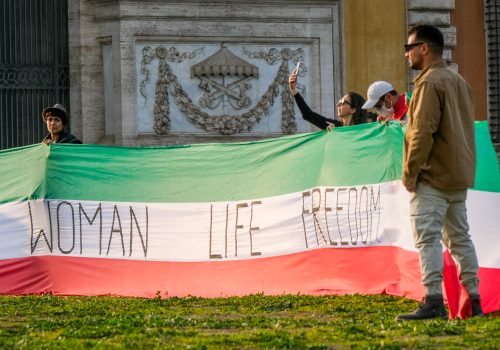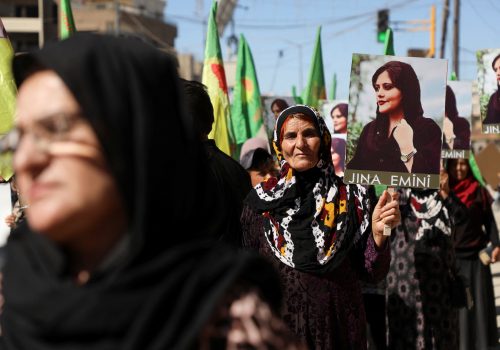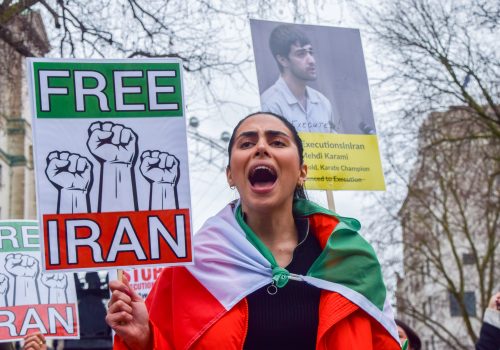Women in Iran fight to break Islamic Republic ‘cage’
“I am a woman. I would die before giving up my values,” roared a woman dressed in white from head to toe in Karaj, west of the capital Tehran. Brandishing her hair in a ponytail, she confronted a security officer threatening her with prison. “The era that we were scared of you has ended,” the woman proclaimed in a video posted on July 20 by Bisimchi Media, a Telegram channel allegedly linked to the security forces.
Unsurprisingly, Bisimchi called for her arrest, with the channel reporting that she was arrested on the same day by security forces for “desecrating sanctities.”
The incident came only days after Iran’s police officially announced on July 16 that the so-called morality police have returned to the streets. This was the same force responsible for the killing of Mahsa Jina Amini in September 2022, which triggered the nationwide Woman, Life, Freedom uprising.
The Islamic Republic has been a festering wound, exporting its poison through the Middle East with terror and asymmetric warfare campaigns. But it has always used the same tactics at home. Since early July, the Islamic Republic has been conducting a phased campaign of terror targeting women refusing to wear the mandatory hijab. But the regime had failed to anticipate the rise of an adversary capable of shattering its iron-clad grip on power: a decentralized resistance network that is not only fighting for political liberation, but life itself—life the way it is meant to be lived, free of shackles.
The terror campaign at home has included the violent arrest of women on the streets, pathologizing them as “hysteric” and “anti-social,” and handing them draconian and degrading sentences, including jail, flogging, and washing corpses in a morgue, according to Amnesty International. In addition to arrests, the regime has also targeted more than one million women with threats of “legal” persecution via text messages, while depriving countless women of access to basic services, such as education, banking, and public transport. Furthermore, hundreds of businesses have been forcibly shut down for not enforcing veiling.
As part of its campaign of enforcing hijab, the regime has also deployed mass surveillance technologies that it claims can identify unveiled women in public spaces while increasing its surveillance of social media. But it is facing resistance.
“We have given blood for shedding the hijab, our chains. We would never retreat from the path we have already traversed,” Leila Ziafar wrote on Twitter on July 19, posting a photo of herself without a headscarf in a Tehran subway station. Hours after the tweet went viral, Bisimchi Media praised her arrest, posting a video of her home being raided.
Over the past weeks, Bisimchi Media has been the primary online outlet publishing such videos, calling for the arrest of “hijab violators” and celebrating their detention, which it later reports in graphic language. In the past, the Telegram channel has published exclusive videos of police raids, leading to the assumption that it is linked to security forces.
Despite all these threats, women in Iran refuse to bend before the Islamic Republic’s enforced hijab campaign. But their resistance comes at a high price. “I don’t know why some people think that we are brave—that we are superhumans. We are just normal people. We are afraid, too. Sometimes, I just want to disappear in the void—to be invisible. But we can’t give up this last stronghold of resistance,” a Tehran-based woman in her early twenties tells me.
Despite many people showing patience and resistance in the face of the headwinds, many are also impatient to see immediate “results” on the ground. And, in most cases, the only win they see fit to be labeled as “victory” is the absolute downfall of the clerical establishment.
Demanding immediate justice and freedom has been a pillar of every liberation movement. Yet, that demand should not distort our understanding of the realities of the battlefield.
Over the past couple of months, this impatience has translated into some people—often foreign-based activists—falling for fake news, such as “cities being liberated” from the Islamic Republic forces or Elon Musk being on the brink of connecting Iranians to uncensored Internet. While the Woman, Life, Freedom uprising has pushed the Islamic Republic to the brink of collapse, there is still a long road ahead before Iran can achieve liberation.
That being said, many who seek to dismantle the regime have honed their patience like the edge of a blade forged in the fire of persecution. They see that every uprising is another link in a long chain that is pulling Iran out of the stark shadow of the Islamic Republic.
A forty-year-old woman tells me about the “itch” she initially felt after she stopped wearing a headscarf outdoors. “I never believed in hijab. I knew the itch was only a residue of the habit of having to wear a headscarf for decades,” she added. Speaking of her fear of the morality police and private citizens enforcing hijab, she said: “In the struggle for freedom, we can only succeed if we persevere. No matter how far and difficult the road is we must be patient and stay strong.”
A chant to break the spell of fear
While the Islamic Republic’s campaign of terror has creeped into people’s daily lives, women in Iran have refused to be crippled with fear. “There are moments during my daily commute to and from work that I feel tendrils of fear creeping [over] me,” a thirty-three-year-old woman from Tehran tells me. “When fear strikes, I start reciting the names of other brave women who have stood tall in the face of oppression: Sepideh Gholian, Nika Shakarami, Sarina Esmaeilzadeh“—the names of an imprisoned activist and two teenage girls slain by security forces, respectively.
The woman says that sometimes she even holds onto her keys or water bottle as weapons to defend herself in case she is attacked by hijab enforcers. Regardless, with her knuckles turning white from clasping the water bottle hard, she keeps walking with her hair waving in the wind and her gaze fixed on a future where the “cage” no longer exists. “I will not return to that cage. I will not bow before bondage,” she says, calling on others to join the resistance: “Together we are stronger than them.”
Another woman, a thirty-three-year-old from the capital, explains to me: “Too many have died because of the forced hijab. So, it was an easy choice when I decided to stop wearing the forced hijab.” Nevertheless, despite her determination, her stomach churns whenever she hears the heavy steps of a bearded man—a tell-tale sign of a regime supporter—or a motorbike approaching her on the streets of Tehran.
“I am constantly afraid they might assault me from behind or burn me by throwing acid in my face. These are all things that have happened in the past to other women seen as defiant,” she adds.
Yet, her courage has prevailed. She notes how she felt the wind blowing through her hair and how it felt. “The first time my hair got wet in the rain, it struck me that, over the past four decades, millions of women in Iran have gone through life deprived of these simple yet beautiful experiences.” The woman says that, initially, she used to have a headscarf in her backpack but stopped carrying one when the regime announced it was using artificial intelligence to identify women not wearing the hijab. “With fear and terror, they hope to force us to wear the hijab. I refuse to bow before terror.”
Despite malicious looks from regime supporters and religious fanatics, most people, according to her, react to her not wearing the hijab with smiles, cheers, and even chants of “Woman, Life, Freedom”—the de facto slogan of the recent uprising.
For life itself
The recent implementation of draconian measures to enforce hijab has once again shown that Supreme Leader Ayatollah Ali Khamenei and his cronies see the forced veiling and subjugation of women as a pillar of their rule—a pilar as pivotal as their animosity towards the West.
At the same time, fearing another social explosion, the clerical establishment has been rolling out its forced hijab campaign in a phased manner to test the waters and see how far it can go with suppressing popular demand for change.
However, top officials, including President Ebrahim Raisi, have tried to distance themselves from the violent campaign, taking a page out of the regime’s asymmetric warfare tactics against its adversaries abroad, where deniability goes hand-in-hand with the Islamic Republic’s clandestine operations.
Yet the regime’s brute force aimed at crushing life has acted as a catalyst. Unlike the past cycles of protest movements in Iran, the current uprising has turned into a fire, forging different social and class groups into a mighty hammer pounding the regime’s clasp on power.
A new front has been born from the womb of this woman-led uprising, where women, men, ethnic and religious minorities, and the queer community are fighting hand-in-hand for not only political liberation, but life itself.
Khosro Sayeh Isfahani is an advocate, journalist, and Internet researcher with years of experience working in Iran, including work related to the LGBTQI community.
Further reading
Thu, Feb 23, 2023
Iran’s ‘women, life, freedom’ revolution has a manifesto. Here are the next steps.
IranSource By
Signed by twenty organizations and released on February 13, the manifesto gathered the support of many civil society organizations in Iran.
Mon, Sep 26, 2022
‘Women, life, liberty’: Iran’s future is female
IranSource By
Women, young and old, have been at the forefront of the uprising, just like every other protest in Iran over the past decades.
Thu, Feb 9, 2023
Forty-four years of an Islamic Republic. Many now regret the 1979 revolution.
IranSource By
While there are disagreements over many aspects of the 1979 revolution, most Iranians agree that the country is in a far worse situation because of it.
Image: Iranian women walk on a street during the revival of morality police in Tehran, Iran, July 16, 2023. Majid Asgaripour/WANA (West Asia News Agency) via REUTERS


